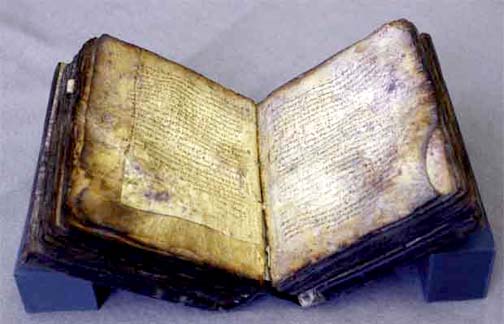On a spring day in April 1229, a Greek Orthodox priest named Johannes Myronas wrote his name carefully on the first page of a prayer book that he had created as a presentation gift. Myronas lived in a monastery in Jerusalem where parchment for his prayer book was scarce. So Myronas recycled. He found some old books in the monastery library, some very old books, washed away the puzzling texts and drawings with orange juice, scraped down the pages and so created his own work. The book to which he so proudly attached his name has been called by today’s historians “a cultural nightmare.”
Flash forward to 1906. Myronas’ prayer book, now in the Metochion Library in the Turkish city that was still Constantinople, was found and examined by the Danish scholar Johan Ludwig Heiberg. Beneath Myronas’ flowing script, Heiberg discovered traces of classical works from the Greek golden age of scientific achievement in the 3rd and 4th centuries BCE, most of which were totally unknown. But Heiberg had neither the time nor the technology to fully unravel the puzzle and shortly thereafter the book disappeared.
It surfaced again in Paris in the 1920s, now in the possession of a French merchant and antique dealer named Salomon Guerson. Guerson was Jewish and by 1938 was feverishly looking for a way to escape Europe. Short of money, Guerson increased the value of Myronas’ prayer book by forging a series of “medieval” miniatures on a few of the book’s blank pages and sold it at a profit. In 1998, the book reappeared and was auctioned by Christie’s to a private buyer who took it to the Walters Art Museum in Baltimore. At the request of the buyer, a full-scale examination of Myronas’ presentation gift took place.
Uncovered beneath the Christian prayers and hymns and Guerson’s forged miniatures were seven original works by the Greek mathematician and inventor Archimedes, two of which were unknown – “The Method of Mechanical Theorems,” in which Archimedes first proposed the theory of infinitesimals, objects so small they can’t be seen (hello, atom), and the “Stomachion,” one of the great puzzle books of all time, so called because trying to solve its puzzle will give you a stomach ache. The value of the find was instantly recognized.
In “The Method,” dedicated by Archimedes to his friend Eratosthenes, the head of the great Library of Alexandria, the mathematician discusses geometry already demonstrated by Euclid, proving for the first time that Euclid preceded Archimedes, and that Archimedes built on his predecessor’s work.
Originally copied out in 975 CE from earlier texts by a scribe in Constantinople, the Greek pages that Myronas so casually erased included speeches by the 4th-century BCE Attic orator Hyperides, 14 folios from a commentary on Aristotle’s “Categories,” and 20 folios from four other books. Almost all of these hidden treasures had been lost for over a thousand years.
In cooperation with the Walters Art Gallery, 20 pages from Myronas’ prayer book, now known as the Archimedes Palimpsest, together with explanatory texts and exhibits will be on display at the Boone Gallery of the Huntington Library through June 22. This battered piece of antiquity carrying its messages from some of the greatest minds of the Greek enlightenment is not to be missed.
The Huntington Library is located at 1151 Oxford Road in San Marino. For more information, visit www.huntington.org.

